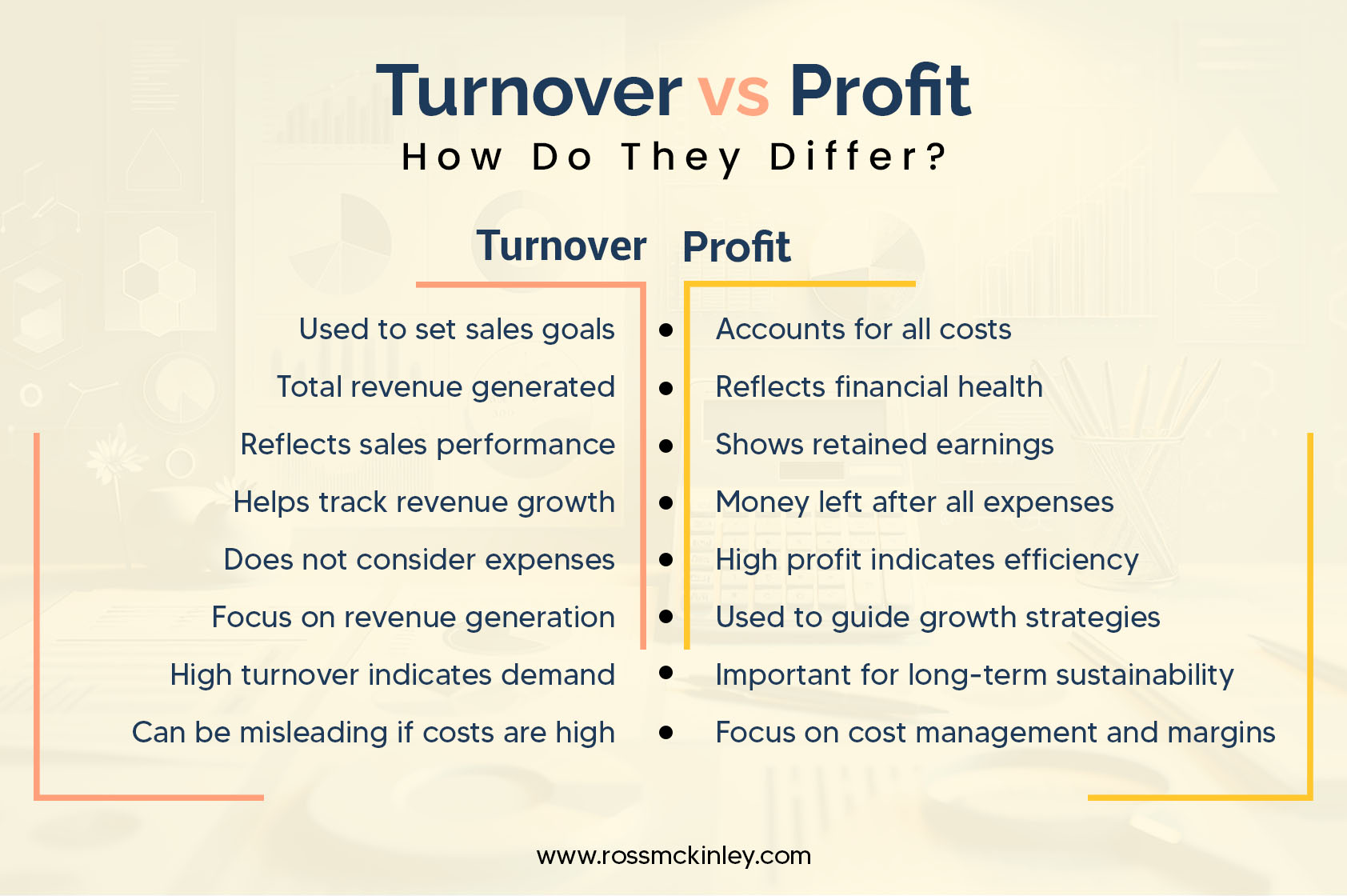
Balance Sheet vs P&L: How Do They Differ?
November 16, 2024
Pros and Cons of Selling Business Assets
November 18, 2024Turnover vs Profit: How Do They Differ?

Many businesses struggle to understand their financial health. One common challenge is the confusion between turnover vs profit. Focusing only on turnover can be misleading. High sales numbers don’t guarantee success if the costs to generate those sales are high.
This mistake can lead to wrong decisions, lack of profitability, and, eventually, failure. Balancing turnover and profit gives a clearer picture of a business’s financial standing. Companies must understand the difference between the two to make smarter decisions and ensure long-term growth.
In this article, we’ll break down the differences between turnover vs profit, explore how they work together, and explain why both are equally important for a company’s success.

Table of Contents
What Is Turnover?
Turnover refers to a business’s total revenue from sales within a specific period. This figure includes income from selling goods or services. However, it doesn’t account for any costs involved in producing those goods or delivering those services.
For example, if a company sells 1,000 units at £10 each, its turnover would be £10,000. There are various types of turnover. In sales, turnover reflects how quickly a company moves its inventory, while in finance, it indicates how often an asset is sold or replaced.
Though turnover highlights sales performance, it does not reveal how much revenue is retained as profit. Businesses must look into their finances to understand their overall profitability.
What Is Profit?
Profit is the money left over after subtracting all expenses from the turnover. It reflects a company’s financial health by showing what it retains from its revenue after paying operating expenses, production costs, salaries, taxes, etc.
Profit is generally divided into two main categories: gross profit and net profit. Gross profit is calculated by subtracting the cost of goods sold (COGS) from turnover. This gives businesses an idea of their core profitability from sales alone, without considering additional expenses.
Net profit, on the other hand, represents what’s left after deducting all operating costs, including taxes and interest. Profit is essential for business growth, reinvestment, and long-term sustainability.
Turnover vs Profit – Differences
Here are some differences between turnover and profit.
| Turnover | Profit |
| Total revenue generated | Money left after all expenses |
| Reflects sales performance | Reflects financial health |
| Does not consider expenses | Accounts for all costs |
| Helps track revenue growth | Shows retained earnings |
| Used to set sales goals | Used to guide growth strategies |
| High turnover indicates demand | High profit indicates efficiency |
| Can be misleading if costs are high | Important for long-term sustainability |
| Focus on revenue generation | Focus on cost management and margins |
Calculation of Turnover and Profit
One of the most significant differences between the two is the calculation of turnover and profit. Turnover is simply the total revenue generated by the business. It is the total sales made in a period without considering costs or expenses.
For example, if a retail store makes £500,000 in monthly sales, its turnover is £500,000. On the other hand, profit is the amount left after all expenses have been subtracted from turnover. Gross profit subtracts the cost of goods sold (such as manufacturing or production costs).
In contrast, net profit considers all other expenses, such as administrative costs, salaries, taxes, etc. A business with a £500,000 turnover might have a much lower net profit after covering all these costs.
Importance of Calculating Turnover and Profit
Turnover and profit are used in different ways. Turnover helps a business measure its revenue-generating capabilities and track sales growth. It shows how well a company performs in selling its products or services.
For example, businesses may compare their turnover across months or years to determine whether they’re increasing sales and attracting more customers. Profit, however, is a much clearer indication of financial health.
It reveals how efficiently a business manages its costs and how much is left for reinvestment or distribution to shareholders. While high turnover indicates good sales performance, a business could struggle if profit is low due to excessive costs. This makes profit the true measure of success.
Impact on Business Decisions
The turnover and profit difference also play an important role in decision-making. When companies evaluate turnover, they focus on sales strategies, marketing efforts, and the efficiency of their sales teams.
For example, if a business sees declining turnover, it might invest more in advertising or adjust product pricing to attract customers and improve sales. However, profit is more important when making decisions about long-term strategy.
Businesses with high turnover but low profits must reduce costs to improve profitability. If net profit is low, management might consider cutting unnecessary expenses, negotiating better supplier deals, or increasing product prices. However, a company with high profit but stable turnover might reinvest in new markets, expand operations, or hire more employees.
Use in Decision-Making
Turnover is commonly used to set sales goals, evaluate marketing budgets, and track how well a business is generating revenue. Businesses with high turnover can celebrate strong demand for their products or services.
However, they must also keep an eye on expenses to ensure that high turnover translates into profit. Profit is the key metric when deciding on growth strategies, including whether to expand, invest in new technology, or increase staffing.
Profit is also what ultimately drives decisions about dividends and payouts to shareholders. The Turnover and Profit difference in decision-making is simple: while turnover measures sales performance, profit is the final indicator of financial success.
How Are Turnover and Profit Equally Important?
Both turnover and profit are vital to business success. High turnover shows that your business generates much revenue, which is essential for covering expenses and growing. However, if costs are too high, even strong turnover won’t lead to sustainable profitability.
At the same time, focusing solely on profit without understanding turnover can also be risky. If your turnover is too low, it might suggest declining market demand or inefficient sales processes.
The challenge is to balance both: businesses need to grow turnover while managing costs effectively to maintain healthy profit margins. Together, turnover and profit provide a full picture of business performance and long-term sustainability.
Conclusion
Understanding the difference between turnover vs profit is essential for any business. While turnover tracks how much revenue a company generates, profit shows what the company retains after covering all costs.
Both metrics are essential, but each tells a different story about a business’s financial health. For businesses planning to grow, balancing turnover and profit is the solution. Ensure that you focus not only on increasing sales but also on managing costs effectively.
Remember, high turnover without profit won’t help in the long term. Always keep both metrics in mind when making decisions for the future.
